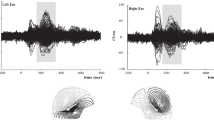Abstract
Between 3 and 6 per cent of children who are otherwise unimpaired have extreme difficulties producing and understanding spoken language1. This disorder is typically labelled specific language impairment. Children diagnosed with specific language impairment often have accompanying reading difficulties (dyslexia)2, but not all children with reading difficulties have specific language impairment3. Some researchers claim that language impairment arises from failures specific to language or cognitive processing4–6. Others hold that language impairment results from a more elemental problem that makes affected children unable to hear the acoustic distinctions among successive brief sounds in speech7–11. Here we report the results of psycho-physical tests employing simple tones and noises showing that children with specific language impairment have severe auditory perceptual deficits for brief but not long tones in particular sound contexts. Our data support the view that language difficulties result from problems in auditory perception, and provide further information about the nature of these perceptual problems that should contribute to improving the diagnosis and treatment of language impairment and related disorders.
This is a preview of subscription content, access via your institution
Access options
Subscribe to this journal
Receive 51 print issues and online access
$199.00 per year
only $3.90 per issue
Buy this article
- Purchase on Springer Link
- Instant access to full article PDF
Prices may be subject to local taxes which are calculated during checkout
Similar content being viewed by others
References
1. Proc. Natl Conf. on Learning Disabilities Bethesda, Maryland, 12 and 13 January 1987 (York, Parkton, MD, 1988). 2. Catts, H. W. The relationship between speech-language impairments and reading disabiities. /. Speech Hear. Res. 36, 948-958 (1993). 3. Aaron, P. G., Kuchta, S. & Grapenthin, C. T. Is there a thing called dyslexia? Annals Dyslexia 36, 33-49 (1988). 4. Aram, D. & Nation, J. Patterns of preschool language disorders. /. Speech Hear. Res. 18, 229-241 (1975). 5. Vellutino, F. R., Steger, B. M., Moyer, S. C., Harding, C. J. & Niles, J. A. Has the perceptual deficit hypothesis led us astray? /. Learn. Dis. 10, 375-385 (1977). 6. Studdert-Kennedy, M. & Mody, M. Auditory temporal perception deficits in the reading-impaired: A critical review of the evidence. Psychon. Bull. Rev. 2, 508-514 (1995). 7. Tallal, P. & Piercy, M. Defects of non-verbal auditory perception in children with developmental aphasia. Nature 241, 468-469 (1973). 8. Frumkin, B. & Rapin, I. Perception of vowels and consonant-vowels of varying duration in language impaired children. Neuropsychologia 18, 443-454 (1980). 9. Lubert, N. Auditory perceptual impairments in children with specific language disorders: A review of the literature. /. Speech Hear. Dis. 46, 3-9 (1981). 10. Elliott, L. L., Hammer, M. A. & Scholl, M. E. Fine-grained auditory discrimination in normal children and children with language-learning problems. /. Speech Hear. Res. 32, 112-119 (1989). 11. Kraus, N. et al. Auditory neurophysiologic responses and discrimination deficits in children with learning problems. Science 273, 971-973 (1996). 12. Fasti, H. Temporal masking effects: II. Critical band noise masker. Acustica 36, 317-330 (1976/77). 13. Soderquist, D. R., Carstens, A. A. & Frank, G. J. H. Backward, simultaneous, and forward masking as a function of signal delay and frequency. /. And. Res. 21, 227-245 (1981). 14. Patterson, R. D., Nimmo-Smith, L, Weber, D. L. & Milroy, R. The deterioration of hearing with age: Frequency selectivity, the critical ratio, the audiogram, and speech threshold. /. Acoust. Soc. Am. 72, 1788-1803 (1982). 15. Patterson, R. D. & Moore, B. C. J. in Frequency Selectivity in Hearing (ed. Moore, B. C. J.) 123-176 (Academic, New York, 1986). 16. Moore, B. C. J., Poon, P. W. F., Bacon, S. P. & Glasberg, B. R. The temporal course of masking and the auditory filter shape. /. Acoust. Soc. Am. 81, 1873-1880 (1987). 17. Carlyon, R. P. Changes in the masked thresholds of brief tones produced by prior bursts of noise. Hear. Res. 41, 223-236(1989). 18. Merzenich, M. M. et al. Temporal processing deficits of language-learning impaired children ameliorated by training. Science 271, 77-81 (1996). 19. Tallal, P. et al. Language comprehension in language-learning impaired children improved with acoustically modified speech. Science 271, 81-84 (1996). 20. Farmer, M. E. & Klein, R. M. The evidence for a temporal processing deficit linked to dyslexia: A review. Psychon. Bull. Rev. 2, 460-493 (1995). 21. Bradley, L. & Bryant, P. E. Difficulties in auditory organisation as a possible cause of reading backwardness. Nature 271, 746-747 (1978). 22. Gauger, L. M., Lombardino, L. J. & Leonard, C. M. Brain morphology in children with specific language impairment. /. Speech Hear. Res. (in the press). 23. Green, D. M. Stimulus selection in adaptive psychophysical procedures. /. Acoust. Soc. Am. 87, 2662-2674(1990). 24. Wagenaar, W. A. Note on the construction of digram-balanced latin squares. Psych. Bull. 72, 384-386 (1969). 25. Semel, E., Wiig, E. & Secord, W. The clinical evaluation of language fundamentals revised (Psychological Corporation, San Antonio, Texas, 1987). 26. Brown, L., Sherbenou, R. J. & Johnson, S. K. Test of nonverbal intelligence (Pro-Ed, Austin, Texas, 1990).
Author information
Authors and Affiliations
Rights and permissions
About this article
Cite this article
Wright, B., Lombardino, L., King, W. et al. Deficits in auditory temporal and spectral resolution in language-impaired children. Nature 387, 176–178 (1997). https://doi.org/10.1038/387176a0
Received:
Accepted:
Issue Date:
DOI: https://doi.org/10.1038/387176a0
This article is cited by
-
Specific language impairment: speech perception in relation to noise
The Egyptian Journal of Otolaryngology (2021)
-
Leitlinie: „Auditive Verarbeitungs- und Wahrnehmungsstörungen“: Diagnostik
HNO (2019)
-
Reading ability and phoneme categorization
Scientific Reports (2018)
-
Diagnostik auditiver Verarbeitungs- und Wahrnehmungsstörungen bei Kindern
HNO (2016)
-
The frequency modulated auditory evoked response (FMAER), a technical advance for study of childhood language disorders: cortical source localization and selected case studies
BMC Neurology (2013)
Comments
By submitting a comment you agree to abide by our Terms and Community Guidelines. If you find something abusive or that does not comply with our terms or guidelines please flag it as inappropriate.



